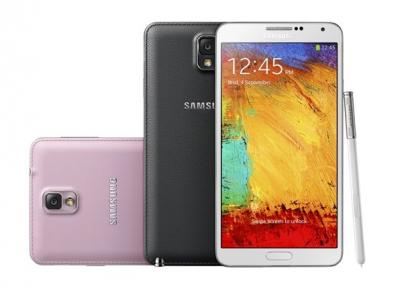DisplayMate, the display testing, measurement and calibration experts just got their hands on a pre-release Galaxy Note 3 production unit, with its 5.7" Full-HD Super AMOLED display (386 PPI, PenTile). They put the unit to extensive testing (and also compared it to the Note 2). The conclusion? This is the best performing OLED display ever and it beats LCDs across the board!

The most notable advancement in this new panel is the high brightness. It can achieve 660 cd/m2 in high ambient light. It's not just 55% brighter than the Note 2, it's actually the brightest display ever tested at DisplayMate. A very notable achievement for Samsung's OLEDs, which were lagging behind LCDs in brightness.
DisplayMate says that this new OLED now exceeds the performance of the best LCDs in every aspect except price: brightness, contrast, color accuracy, color management, picture quality, screen uniformity and viewing angles.
UDC investors will be happy to hear that the Note 3 is 26% more efficient compared ot the Note 2, which seems to confirm that Samsung is using a green PHOLED in this display (similarly to the GS4). DisplayMate says that the Note 3 is 31% more efficient than the Full-HD LCD smartphones they tested when showing mixed image content (50% average picture level).
Comments
Well maybe it's more brightness but I think the best displays for now is Super AMOLED Plus aka RGB Amoled. So I think Moto X have the best display for mobile phone (for now). But I really don't understand what type of amoled uses Blackberry Z30...But anyway Samsung done a great job. Wait for Samsung's Full HD RGB Amoled matrix and FOLED.
I disagree with you guys, Samsung do bad OLEDs display, which are still inferior (bad color, not RGB) compared to good LCD (especially IGZO) and not reliable.
I still wait for good OLED from JDI (RGB OLED) and Sharp (IGZO OLED), and the sony-panasonic joint venture.
In other words your butthurt .Most likely because you've been ranting against Samsung or Oled tech all together because of some twisted personal Fanboy beliefs. Probably an I sheep. The fact is the oled on the note 3 surpasses the tiny iPhone screen on virtually every metric that matters. There are several different display settings on the note 3 so there goes the over saturation complaint.
It has the bad PenTile RGBG matrix. The true resolution is like 1/4 to 1/3 less. Only on paper the number of pixels and thus the PPI is high. This way Samsung obviously saves money but also lies to its customers about the true resolution. But since the majority isn't smart, they don't care. And yes: In some situations this matrix shows its disadvantages to the naked eye, despite the pixel density. It was especially bad on S3, but S4 not as bad.
Yeah and what is the name of your reputable testing lab? JDI and Sharp, Sony and Panasonic? Sounds like you're a Japanese that can get over the fact that your Korean superiors are way ahead. You keep waiting.
Whenever I read these phoney posts, I just got a laugh. Galaxy S3 is still selling for just as much as it's comparable HTC and Apple phones. If you ask people that have owned them, still own them or just bought them about PenTile.... they look at like you're from Mars and say, "What the hell is that". Nobody but idiots ever notice what kind of subpixel array it has. You act likely other fools thinking Samsung is somehow cheating us with Super Amoled screens and the last two years alone, consumers have been apparently ignoring you HATERS.... and buying Samsung's superior devices.
Do yourself a favor and go out and get a real life! ;-P .....it's only you that sees any difference made up all in your own Deluded.... MIND!
They were bad, but not anymore. Note 4 is probably the only one offers 100% adobe RGB and 100% sRGB in one phone...that is very cool. One day 100% sRGB will be insuffcient, OLED will be the better choice before IPS LCD can find a better backlit source.


It's incredible to think that it's only been 3 years since mass-market OLED screens have been available, and already, they are outpacing the very best that LCD has to offer -- and these are still very early days. When new materials improve the efficiencies of blue and red sub-pixels, when new manufacturing techniques bring the price down, when OLEDs are routinely printed on flexible, oddly-shaped substrates, when more applications require ultra-fast screen refreshing (eg. VR), etc, there will be few places for LCD left to stand as a leading consumer electronic display technology.
As a proponent of OLED, I feel validated by this latest generation of screens and their performance. What is more, I will be quite pleased to see the rampant tech-blogger pessimism toward the technology radically-shift from anti-AMOLED-saturation, to pro-AMOLED-quality. The technology now occupies the top seat among displays, and it enables capabilities not-possible with LCD (eg. always on display) -- any argument against it is now irrifutably academic.
Of course, there is still plenty of room to imrpove -- notably efficiencies with maximum illumination, colour accuracy in ambient conditions, and manufacturing costs -- and I'm looking forward to next-year's screens. Plastic OLED screens with a Diamond Like Coating would also be intensly cool, and provide shatter-proof displays and significantly lighter mobiles.
Samsung has done a fantastic job with these screens and they deserve much more credit than they will undoubtedly get. Thanks for sharing this news!